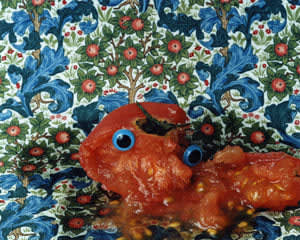Works
Biography
If the proto-surrealist painter Arcimboldo had been a sushi chef, his creations might have looked something like Yumiko Utsu’s deliciously unsettling images.
Combining the intricate techniques of food photography with the anthropomorphic tendencies of manga, Utsu has an affinity for kitsch shared by British photographer Martin Parr. But instead of taking a strict documentary approach to the Japanese relationship with food and the natural world, she uses fruit, vegetables, and seafood to construct surreal fantasies populated by kittens with octopus eyes, pineapples full of owls, and phallic carrots. Several contemporary Japanese artists – perhaps the most famous of whom is Takashi Murakami – reference manga, with its bug eyed cartoon characters and anthropomorphized objects, in order to subvert modern Japanese culture. But by using the visceral, perishable products of nature to reinvent such imagery Utsu goes further, undermining the antiseptic values of the genre, pricking its glossy surface with a shudder of amused repulsion. By exposing the strangeness of manga’s visual strategies she also reveals our complex relationship to the natural world and to our own bodies – at once sensual and comic, tinged by eroticism, disgust, and desire.
Utsu has stated that her favourite artist is Czech animator Jan Švankmajer, whose surrealist short film Food (1992) revels in the disturbing, humorous, and sexual desire responses we have to the culinary arts. Likewise, Utsu’s photographic series suggest stills from an animated film, and portray similarly comic but uncomfortable scenarios: a seated bear in a volcanic landscape seems to erupt in a fountain of chocolate; a head of Romanesco broccoli is transformed into an alpine landscape; and a wide-eyed tomato gradually decomposes into a pulpy mass. By extracting individual moments from these imagined situations Utsu allows us to luxuriate in the pure visual pleasure of her creations, while giving us time to reflect on the significance of her bizarre humor. As William Burroughs said when explaining the name of his successful novel: “The title means exactly what the words say: naked lunch, a frozen moment when everyone sees what is on the end of every fork”.
Yumiko Utsu was born in Tokyo in 1978. She has had solo exhibitions in Japan and Hungary and her work has been collected by Charles Saatchi. The work shown at the Michael Hoppen Gallery demonstrates both the consistency of Utsu’s creative outlook and the rich variation of her imagination. Images of naive innocence, scatological humor and direct sexuality make the introduction to Utsu’s world a disturbingly seductive experience.
Exhibitions
Enquire









